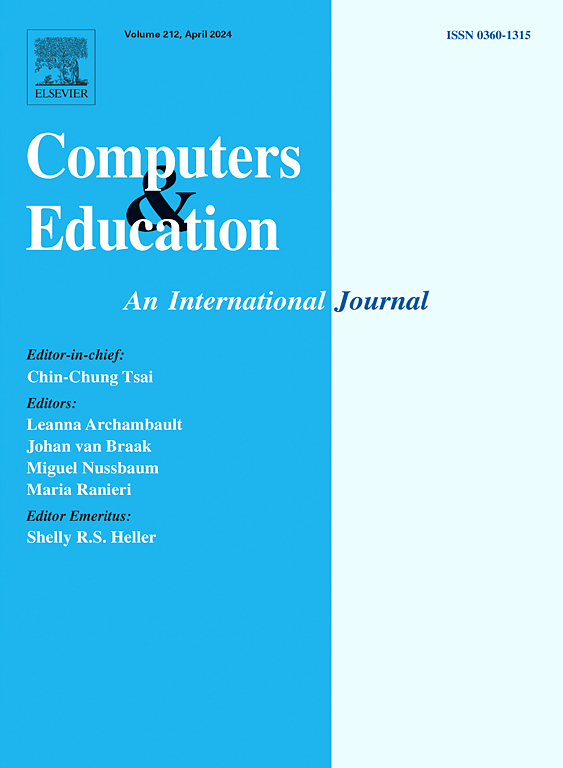Exploring characteristics of primary school students’ self-regulated learning (SRL) behaviors in human-GenAI collaborative programming learning environments: Insights from a proposed framework
IF 10.5
1区 教育学
Q1 COMPUTER SCIENCE, INTERDISCIPLINARY APPLICATIONS
引用次数: 0
Abstract
Programming education in primary school is vital for nurturing future-ready talents, yet primary school students often struggle with self-regulated learning (SRL), particularly in resource utilization and strategy regulation. Although human-generative AI (GenAI) collaborative programming learning might have the potential to enhance personalized programming education, GenAI's interplay with SRL processes remains underexplored. To address this gap, this study first proposed a SRL Behavior Analysis Framework for human-GenAI collaborative programming learning environments and then examined SRL behaviors of a group of sixth-grade students (n = 36) in such an environment using this framework, along with various learning analytics methods including cluster analysis, descriptive statistics and lag sequential analysis. The analysis yielded the following results: (1) Based on their learning performance, primary school students were identified as three distinct clusters: programming specialized unit (PSU), high performance unit (HPU), and low performance unit (LPU). (2) Regarding SRL behaviors, students prioritized self-control (65.8 %), followed by self-observation (19 %), task analysis (12.1 %), and behavior stagnation (3.2 %). (3) Students in PSU and HPU consistently adopted goal-oriented SRL strategies, whereas students in LPU exhibited passive dependence and fragmented strategy use. GenAI's facilitative effect in supporting learning correlated with users' SRL capabilities. (4) Students in PSU and HPU exhibited frequent transitions between SRL behaviors, whereas students in LPU had insufficient ability to switch strategies when facing programming difficulties. Based on these findings, this study proposed four forward-looking design recommendations: effectively integrating GenAI with the programming environment, utilizing multimodal data and AI for learning assessment and feedback, building a cluster-driven early warning mechanism, and conducting dynamic SRL analysis and guidance based on fine-grained time-series data.
人类-基因人工智能协同编程学习环境下小学生自我调节学习行为特征研究:基于框架的洞察
小学编程教育对于培养面向未来的人才至关重要,但小学生往往存在自我调节学习(SRL)的困难,尤其是在资源利用和策略调节方面。尽管人类生成人工智能(GenAI)协作编程学习可能具有增强个性化编程教育的潜力,但GenAI与SRL过程的相互作用仍未得到充分探索。为了解决这一差距,本研究首先提出了一个用于人类- genai协作编程学习环境的SRL行为分析框架,然后使用该框架研究了一组六年级学生(n = 36)在该环境中的SRL行为,以及各种学习分析方法,包括聚类分析、描述性统计和滞后序列分析。分析结果显示:(1)根据小学生的学习表现,将小学生划分为编程专业单元(PSU)、高性能单元(HPU)和低性能单元(LPU)三个不同的集群。(2)在SRL行为方面,学生优先选择自我控制(65.8%),其次是自我观察(19%)、任务分析(12.1%)和行为停滞(3.2%)。(3) PSU和HPU学生普遍采用目标导向的SRL策略,而LPU学生表现出被动依赖和碎片化策略使用。GenAI在支持学习方面的促进作用与用户的SRL能力相关。(4) PSU和HPU的学生在面对编程困难时表现出频繁的SRL行为转换,而LPU的学生在面对编程困难时转换策略的能力不足。基于这些发现,本研究提出了四项前瞻性设计建议:将GenAI与编程环境有效集成,利用多模态数据和AI进行学习评估和反馈,建立集群驱动的预警机制,以及基于细粒度时间序列数据进行动态SRL分析和指导。
本文章由计算机程序翻译,如有差异,请以英文原文为准。
求助全文
约1分钟内获得全文
求助全文
来源期刊

Computers & Education
工程技术-计算机:跨学科应用
CiteScore
27.10
自引率
5.80%
发文量
204
审稿时长
42 days
期刊介绍:
Computers & Education seeks to advance understanding of how digital technology can improve education by publishing high-quality research that expands both theory and practice. The journal welcomes research papers exploring the pedagogical applications of digital technology, with a focus broad enough to appeal to the wider education community.
 求助内容:
求助内容: 应助结果提醒方式:
应助结果提醒方式:


